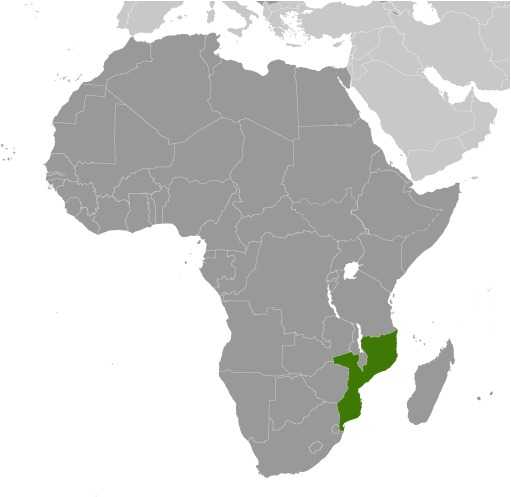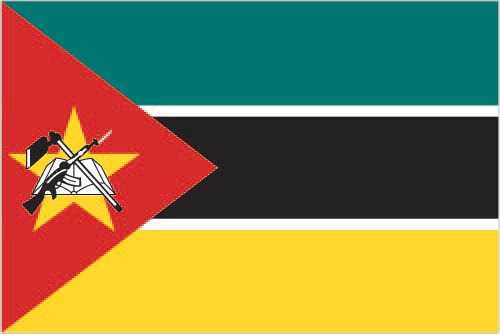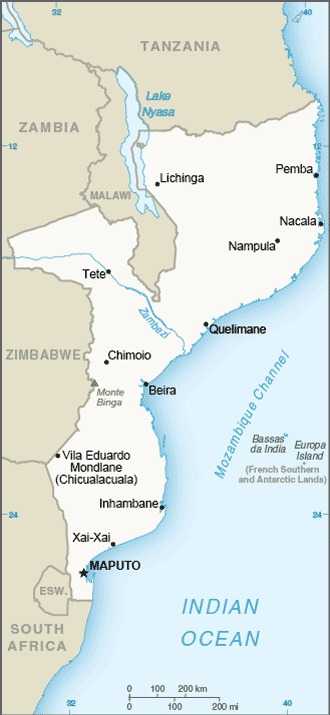Introduction
Background
Mozambique ended almost five centuries as a Portuguese colony when it gained independence in 1975. Large-scale emigration, economic dependence on South Africa, a severe drought, and a prolonged civil war hindered the country's development until the mid-1990s.
Geography
Area
total: 799,380 sq km
land: 786,380 sq km
water: 13,000 sq km
Climate
tropical to subtropical
Natural resources
coal, titanium, natural gas, hydropower, tantalum, graphite
People and Society
Population
total: 33,350,954
male: 16,449,734
female: 16,901,220 (2024 est.)
Ethnic groups
African 99% (Makhuwa, Tsonga, Lomwe, Sena, and others), Mestizo 0.8%, other (includes European, Indian, Pakistani, Chinese) 0.2% (2017 est.)
Languages
Makhuwa 26.1%, Portuguese (official) 16.6%, Tsonga 8.6%, Nyanja 8.1, Sena 7.1%, Lomwe 7.1%, Chuwabo 4.7%, Ndau 3.8%, Tswa 3.8%, other Mozambican languages 11.8%, other 0.5%, unspecified 1.8% (2017 est.)
Religions
Roman Catholic 27.2%, Muslim 18.9%, Zionist Christian 15.6%, Evangelical/Pentecostal 15.3%, Anglican 1.7%, other 4.8%, none 13.9%, unspecified 2.5% (2017 est.)
Population growth rate
2.54% (2024 est.)
Government
Government type
presidential republic
Capital
name: Maputo
Executive branch
chief of state: President Filipe Jacinto NYUSI (since 15 January 2015); note - the president is both chief of state and head of government
head of government: President Filipe Jacinto NYUSI (since 15 January 2015); Prime Minister Adriano Afonso MALEIANE (since 3 March 2022); note - President NYUSI removed Prime Minister Carlos Agostinho DO ROSARIO from office on 3 March 2022 as part of a cabinet reshuffle
Legislative branch
description: unicameral Assembly of the Republic or Assembleia da Republica (250 seats; 248 members elected in multi-seat constituencies by party-list proportional representation vote and 2 members representing Mozambicans abroad directly elected by simple majority vote; members serve 5-year terms)
Economy
Economic overview
low-income East African economy; subsistence farming dominates labor force; return to growth led by agriculture and extractive industries; Islamist insurgency threatens natural gas projects in north; ongoing foreign debt restructuring and resolution under IMF Highly Indebted Poor Countries (HIPC) initiative
Real GDP (purchasing power parity)
$41.237 billion (2022 est.)
$39.515 billion (2021 est.)
$38.597 billion (2020 est.)
Real GDP per capita
$1,300 (2022 est.)
$1,200 (2021 est.)
$1,200 (2020 est.)
Agricultural products
cassava, sugarcane, maize, tomatoes, sweet potatoes, beans, bananas, onions, rice, coconuts (2022)
Industries
aluminum, petroleum products, chemicals (fertilizer, soap, paints), textiles, cement, glass, asbestos, tobacco, food, beverages
Exports
$9.409 billion (2022 est.)
$6.404 billion (2021 est.)
$4.37 billion (2020 est.)
Exports - partners
India 22%, South Africa 9%, South Korea 8%, Italy 7%, China 6% (2022)
Exports - commodities
coal, aluminum, coke, natural gas, gold (2022)
Imports
$15.913 billion (2022 est.)
$10.392 billion (2021 est.)
$8.661 billion (2020 est.)
Imports - partners
South Africa 23%, South Korea 20%, China 12%, India 10%, Democratic Republic of the Congo 5% (2022)
Imports - commodities
ships, refined petroleum, iron alloys, chromium ore, refined copper (2022)
Exchange rates
meticais (MZM) per US dollar -
Exchange rates:
63.851 (2022 est.)
65.465 (2021 est.)
69.465 (2020 est.)
62.548 (2019 est.)
60.326 (2018 est.)
Page last updated: Wednesday, May 22, 2024




